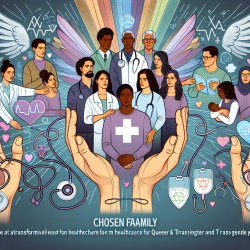Introduction
In the realm of speech-language pathology and beyond, understanding the unique social structures that support the health and well-being of queer and transgender (Q/T) individuals is crucial. The concept of "chosen family" has emerged as a significant theme in providing care and support, as illustrated in the research article, “We Just Take Care of Each Other”: Navigating ‘Chosen Family’ in the Context of Health, Illness, and the Mutual Provision of Care amongst Queer and Transgender Young Adults. This blog explores how practitioners can leverage these insights to improve their engagement with Q/T individuals and their support networks.
Understanding 'Chosen Family'
Chosen family refers to the non-biological, non-legal familial networks that Q/T individuals often form to provide mutual care and support. These networks are particularly vital for those who may face rejection or lack of understanding from their families of origin. The research by Levin et al. (2020) highlights how chosen families play a pivotal role in navigating health systems, providing emotional support, and engaging in mutual aid.
Key Findings and Their Implications
- Navigating Medical Systems: The study found that Q/T individuals often rely on chosen family members to accompany them to medical appointments as advocates. This is crucial in mitigating medical trauma and ensuring respectful treatment, particularly in environments that may not be fully inclusive.
- Leaning on Each Other: Emotional support is a cornerstone of chosen family dynamics. The shared experiences and identities within these networks allow for a deeper understanding and more effective support, particularly in managing mental health challenges.
- Mutual Aid: Chosen families often engage in mutual aid, sharing resources like housing, transportation, and financial support. This system of reciprocity ensures that members can rely on each other in times of need, reinforcing the network's resilience.
Practical Applications for Practitioners
Practitioners can enhance their service delivery by acknowledging and integrating the concept of chosen family into their practice. Here are some strategies:
- Recognize chosen family members as legitimate support figures in medical and therapeutic settings.
- Facilitate discussions about chosen family networks during assessments to understand the client's support system better.
- Advocate for policies that acknowledge and respect chosen family dynamics in healthcare settings.
Encouraging Further Research
The study by Levin et al. provides a foundational understanding of chosen family dynamics, but there is much more to explore. Future research could focus on the specific roles of chosen family members in various health contexts, the long-term impacts of these networks on health outcomes, and strategies to better integrate chosen family support into formal healthcare systems.
To read the original research paper, please follow this link: “We Just Take Care of Each Other”: Navigating ‘Chosen Family’ in the Context of Health, Illness, and the Mutual Provision of Care amongst Queer and Transgender Young Adults.










